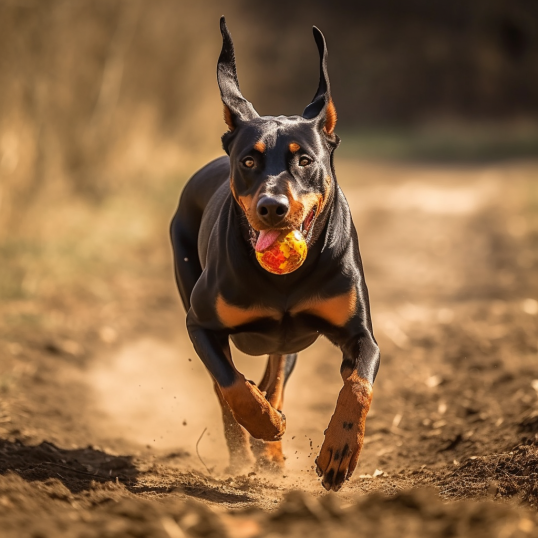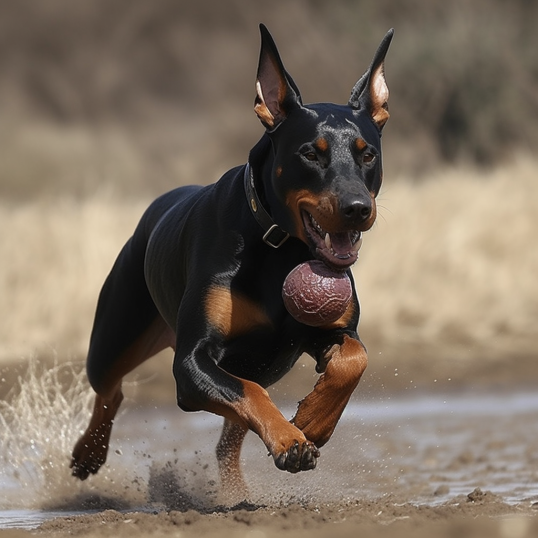Introduction: The Doberman Breed and the Importance of Training

Dobermans, with their sleek coat, athletic build, and regal appearance, are one of the most distinguished breeds in the canine kingdom. Originally bred by a German tax collector named Louis Dobermann in the late 19th century, these dogs were designed to be protective, loyal, and intelligent. In fact, their creator wanted a medium-sized dog that could serve as both a companion and a protector, thus birthing the Doberman breed we know today.
Dobermans come with a powerful physique, standing between 24 to 28 inches tall at the shoulder and weighing anywhere from 60 to 100 pounds. What truly sets them apart, however, is their sharp intellect. Ranked as the fifth smartest breed in terms of obedience and work intelligence, Dobermans are capable of learning and executing complex tasks.
These qualities have made them popular choices for various roles such as police dogs, search and rescue dogs, and therapy dogs. However, they can also make wonderful pets, provided they are given the right training and socialization from an early age.
This brings us to the importance of training for Doberman dogs. Their intelligence and energy mean that Dobermans need mental stimulation just as much as they need physical exercise. Without proper training, these dogs can develop behavioral issues, including aggression and destructiveness. Training not only helps curb these potential problems but also strengthens the bond between you and your Doberman, ensuring a harmonious coexistence.
In this blog post, we’ll dive deeper into understanding your Doberman and how to effectively train this remarkable breed. Whether you’re a new Doberman owner or have had one for years, there’s always something new to learn about these fascinating dogs. So, let’s get started!
Understanding Your Doberman: Characteristics, Traits, and Common Behaviors

Understanding your Doberman’s unique characteristics and traits is the first step towards effective training. Let’s explore the key features that define this breed.
Characteristics and Traits of Dobermans
Dobermans are known for their loyalty, intelligence, and strong protective instincts. They are highly energetic and require regular exercise to keep them mentally and physically fit. Their sharp intellect makes them quick learners, which can be a double-edged sword. While they can pick up commands and tricks quickly, they can also learn unwanted behaviors if not properly guided.
One of the defining traits of a Doberman is its protective nature. They are naturally inclined to protect their family and territory, which can make them wary of strangers. This trait, while beneficial in many circumstances, needs to be managed through proper socialization and training to prevent overprotectiveness or aggression.
Another important characteristic is their sensitivity. Despite their tough exterior, Dobermans are emotionally sensitive dogs. They thrive on positive reinforcement and can become anxious or upset with harsh treatment or changes in their environment.
Common Behaviors and What They Mean
Understanding common Doberman behaviors can give you insight into their mindset and help you communicate more effectively with your dog.
- Barking: Dobermans bark to alert their owners of potential threats, express excitement, or signal discomfort. Frequent or excessive barking could indicate boredom or anxiety.
- Nudging or Pawing: This is a common way Dobermans seek attention or affection. It can also be a sign that they want something, like food or playtime.
- Chewing: Like many other breeds, Dobermans may chew on objects, especially when they’re puppies. This can be a sign of teething, boredom, or anxiety.
- Tail Wagging: While tail wagging generally signifies happiness, Dobermans also wag their tails when they’re excited or aroused. Rapid tail wagging could indicate alertness or agitation.
- Leaning: Dobermans are known as “Velcro dogs” because they love being close to their owners. They often lean against their favorite humans as a sign of affection and trust.
Remember, every Doberman is an individual with its own personality and quirks. By observing and understanding your Doberman’s unique behaviors, you’ll be better equipped to provide the right training and care for your loyal companion.
Preparing for Training: Essential Tools and Environment Set-Up

Before you jump into training your Doberman, it’s crucial to prepare the necessary tools and create a conducive environment that encourages learning. Here are some tips to get you started.
Essential Tools for Training Your Doberman
- Collar and Leash: These are basic necessities for any dog owner. A sturdy collar and leash will help you maintain control of your Doberman during training sessions and walks.
- Training Treats: Treats are an excellent reinforcement tool. Opt for small, low-calorie treats that can be given frequently without affecting your Doberman’s diet.
- Clicker: A clicker is a useful tool for marking desirable behavior. The distinct sound helps your Doberman understand exactly what action is being rewarded.
- Toys: Toys can be used as rewards or to redirect unwanted behaviors. Ensure you choose durable toys suitable for your Doberman’s size and chewing strength.
- Training Pads: If you’re house training a puppy, training pads can be helpful. They can also be useful for older dogs in certain situations, such as bad weather.
- Crate: A crate can provide a safe and comfortable space for your Doberman, aiding in house training and preventing destructive behavior when unsupervised.
Setting Up a Conducive Environment for Training
Creating a training-friendly environment is equally important. Here are some factors to consider:
- Distraction-Free Zone: Start training in a quiet, distraction-free area where your Doberman can focus on you and the task at hand. As they get better, gradually introduce distractions.
- Consistent Schedule: Consistency is key in dog training. Try to conduct training sessions at the same time each day. This helps your Doberman understand when it’s time to learn and focus.
- Safe Space: Ensure the training area is safe and secure. Remove potential hazards that could harm your Doberman or distract them during training.
- Comfort: Make sure your Doberman is comfortable before starting a training session. This means they should be well-rested, not too hungry or full, and in a calm state of mind.
Remember, preparation is a crucial step towards successful training. By equipping yourself with the right tools and setting up a conducive environment, you’re setting the stage for a positive and productive training experience with your Doberman.
Basic Obedience Training: Simple Commands and Positive Reinforcement

Teaching your Doberman basic obedience commands is a crucial part of their training. Not only do these commands help in managing your dog’s behavior, but they also serve as building blocks for more complex skills. Moreover, the use of positive reinforcement techniques can make the training process more enjoyable and effective for both you and your Doberman.
Teaching Simple Commands
Here are some steps to teach fundamental commands such as ‘sit’, ‘stay’, and ‘come’:
- Sit: Hold a treat close to your Doberman’s nose, then move your hand up, allowing their head to follow the treat and causing their bottom to lower. Once they’re in a sitting position, say ‘sit’, give them the treat, and share affection.
- Stay: This command is essential for your Doberman’s safety. Ask your dog to sit, then open your palm in front of you and say ‘stay’. Take a few steps back and if they stay, give them a treat. Gradually increase the distance over time.
- Come: This command can help keep your dog out of trouble and bring them back to you if they slip out of their leash. Put a leash and collar on your Doberman, go down to their level and say ‘come’ while gently pulling the leash. When they come to you, reward them with a treat and affection.
Remember, patience and consistency are key when teaching these commands. It might take some time for your Doberman to master these skills, but with regular practice, they’ll get there.
Positive Reinforcement Techniques
Positive reinforcement involves rewarding your dog for performing a desired behavior, which increases the likelihood of the behavior being repeated. Here are some techniques:
- Treats: These are the most common rewards used in dog training. Always have a stash of your Doberman’s favorite treats during training sessions.
- Praise and Affection: Verbal praise (“Good dog!”) and physical affection (like petting or cuddling) can be just as rewarding as treats.
- Toys and Playtime: If your Doberman has a favorite toy or enjoys a particular game, these can be used as rewards.
- Clicker Training: A clicker can effectively communicate to your Doberman the exact moment they did something right. The sound of the clicker is followed by a treat, which helps your dog associate the sound with a reward.
Always remember to immediately reward your Doberman after they perform the desired behavior. The quicker the reward, the better your dog will understand what it’s for. With time, patience, and consistent application of these techniques, your Doberman will not only learn the basics but will also enjoy the process.
Socialization Training: Importance and Tips for Success
Socialization is an essential part of your Doberman’s training that should not be overlooked. It involves exposing your dog to a variety of people, animals, environments, and experiences to help them become well-adjusted, confident, and well-behaved.
Importance of Socializing Your Doberman
Dobermans are known for their protective nature, which can sometimes lead to wariness or even aggression towards strangers if not properly managed. Socialization helps your Doberman learn how to behave appropriately around other people and pets, reducing the likelihood of fear, anxiety, or aggression.
Moreover, socialized Dobermans are generally happier and more relaxed in different situations, whether it’s a walk in the park, a visit to the vet, or a family gathering at home. It allows them to enjoy a broader range of experiences without stress or fear.
Tips for Successful Socialization with Other People and Pets
Here are some tips to help you socialize your Doberman effectively:
- Start Early: The best time to start socializing your Doberman is when they’re a puppy. The experiences they have during this period can significantly shape their future behavior. However, older Dobermans can also be socialized — it might just require a bit more patience and effort.
- Gradual Exposure: Introduce your Doberman to new experiences gradually. Start with calm, controlled environments before moving on to more crowded or noisy places.
- Positive Experiences: Ensure each socialization experience is positive. Use treats, praise, and toys as rewards for calm and polite behavior during social interactions.
- Variety is Key: Expose your Doberman to a wide range of people (different ages, genders, appearances) and animals to help them become comfortable in various situations.
- Obedience Training: Basic obedience commands like ‘sit’, ‘stay’, and ‘leave it’ can be very useful during socialization. They give you control over your Doberman’s behavior and can prevent them from becoming overly excited or aggressive.
- Consistency: Regular socialization opportunities are crucial. The more your Doberman is exposed to different situations, the more comfortable they will become.
Remember, socialization should be a fun and positive experience for your Doberman. With patience, consistency, and lots of love, you can help your Doberman become a friendly and well-mannered member of your community.
Advanced Training Techniques: Complex Commands and Dog Sports
Once your Doberman has mastered basic obedience and socialization skills, you may want to challenge them with more advanced training. This can include complex commands and preparation for dog sports like agility. These activities not only stimulate your Doberman’s mind but also provide great physical exercise.
Teaching Complex Commands
Complex commands can vary widely depending on what you want your Doberman to learn. Here are some general tips:
- Build on Basics: Many complex commands are extensions of basic ones. For instance, ‘stay’ can be extended to ‘stay until I call’, and ‘fetch’ can be expanded to fetching specific items.
- Break it Down: Break down complex commands into smaller, manageable steps. Reward your Doberman for successfully completing each step before moving on to the next.
- Patience and Consistency: Teaching complex commands requires patience. It might take weeks or even months for your Doberman to fully understand and consistently respond to a complex command. Keep training sessions short and positive to prevent frustration.
- Practice in Different Environments: Once your Doberman has mastered a command at home, practice it in different environments to reinforce their learning.
Training Your Doberman for Agility and Other Dog Sports
Dobermans are intelligent, energetic dogs that excel in various dog sports, including agility. Here’s how to get started:
- Basic Obedience: Your Doberman should have a solid foundation of basic obedience skills before starting agility training. Commands like ‘sit’, ‘stay’, ‘come’, ‘down’, and ‘leave it’ are particularly important.
- Start with Basic Agility Tasks: Begin with simple tasks like walking over a low beam or jumping through a hoop. Gradually increase the difficulty as your Doberman becomes more confident.
- Use Positive Reinforcement: Always reward your Doberman for successfully completing an agility task. This can be a treat, toy, praise, or a combination of these.
- Stay Patient and Positive: Agility training can be challenging and requires a lot of patience. Keep the training sessions fun and positive to motivate your Doberman.
- Consider Joining a Club or Class: An agility club or class can provide structured training and the opportunity for your Doberman to socialize with other dogs.
Advanced training requires commitment and patience, but the rewards are well worth it. Not only will it strengthen the bond between you and your Doberman, but it will also provide your dog with the mental stimulation and physical exercise they need to stay happy and healthy.
Dealing with Behavioral Issues: Common Problems and Effective Strategies
Like any breed, Dobermans may develop behavioral issues that need addressing. Understanding these common problems and knowing how to effectively tackle them is key to ensuring your Doberman grows into a well-mannered and balanced dog.
Common Behavioral Problems in Dobermans
Here are some common behavioral issues you might encounter:
- Aggression: Dobermans are protective dogs, but this trait can sometimes lead to aggressive behavior if not properly managed. This could be directed towards strangers, other animals, or even their owners in some cases.
- Separation Anxiety: Dobermans are known for their loyalty and strong bond with their owners, which can lead to distress when left alone.
- Excessive Barking: While Dobermans are typically quiet dogs, they can resort to excessive barking due to boredom, anxiety, or a perceived threat.
- Chewing and Digging: These behaviors can be a sign of boredom, lack of exercise, or anxiety.
Effective Strategies for Addressing These Issues
Here are some strategies to address these behavioral problems:
- Professional Help: If your Doberman shows signs of aggression, it’s crucial to seek help from a professional dog trainer or behaviorist. They can assess the situation and provide personalized training strategies.
- Prevent Separation Anxiety: Gradually accustom your Doberman to being alone to prevent separation anxiety. Start by leaving them alone for short periods and gradually increase the time. Provide toys and activities to keep them entertained while you’re gone.
- Address Excessive Barking: Determine the cause of the barking. If it’s due to boredom, provide more physical exercise and mental stimulation. If anxiety is the cause, try to remove the trigger or use calming techniques. Training your Doberman to obey commands like ‘quiet’ can also be helpful.
- Redirect Chewing and Digging: Provide chew toys and engage your Doberman in stimulating activities. If the behavior persists, consider seeking advice from a professional.
Remember, patience and consistency are key when dealing with behavioral issues. Always use positive reinforcement methods and avoid punishment, as it can lead to fear and further behavioral problems. Most importantly, understand that behavioral issues can be a sign of underlying problems such as stress, fear, or health issues, so make sure your Doberman is healthy, happy, and well-cared-for.
Maintaining Your Training Efforts: Consistency and Skill Sharpening
After spending time and effort teaching your Doberman basic commands, socialization skills, advanced techniques, and addressing behavioral issues, it’s crucial to maintain these efforts. Continuous training helps keep your Doberman’s skills sharp and reinforces their good behavior.
The Importance of Consistency in Training
Consistency is key in dog training. Your Doberman needs to understand that rules and commands apply at all times, not just during training sessions. If you’re inconsistent, your Doberman may become confused, leading to setbacks in their progress.
For instance, if you’ve taught your Doberman not to jump on people, but then allow them to do so when you’re in a good mood, this sends mixed signals. Your Doberman won’t understand when it’s acceptable to jump and when it isn’t.
Tips for Keeping Your Doberman’s Skills Sharp
Keeping your Doberman’s skills sharp doesn’t have to be complicated or time-consuming. Here are some tips:
- Regular Practice: Incorporate training into your daily routine. This could be practicing obedience commands during walks or playtime.
- Revisit Basic Commands: Even after your Doberman has mastered a command, it’s beneficial to revisit it regularly. It reinforces the command and ensures your Doberman doesn’t forget it.
- Challenge Your Doberman: Once your Doberman has mastered a skill or command, make it more challenging. For instance, increase the duration of the ‘stay’ command or practice it in a more distracting environment.
- Keep Training Fun: Make sure training remains a positive experience for your Doberman. Use treats, praise, and toys to keep them motivated.
- Stay Patient: There will be days when your Doberman seems to forget everything they’ve learned. Don’t get frustrated. Be patient and keep practicing.
Remember, maintaining your training efforts is as important as the initial teaching phase. With consistency, patience, and a bit of creativity, you can ensure your Doberman remains well-behaved and their skills stay sharp, allowing both of you to enjoy a strong and rewarding bond.
Conclusion: Recap and Encouragement for Continued Training
Training your Doberman is a journey, one that requires time, patience, consistency, and a lot of love. But the rewards, from a well-behaved pet to a deep, trusting bond, are well worth the effort.
Let’s recap what we’ve covered:
- Basics First: Start with basic commands like ‘sit’, ‘stay’, ‘come’, and ‘leave it’. These form the foundation for more advanced training.
- Socialization is Key: Expose your Doberman to different people, environments, and situations to help them become well-rounded and confident dogs.
- Advanced Training Techniques: Once your Doberman has mastered the basics, challenge them with more complex commands and consider dog sports like agility for physical and mental stimulation.
- Behavioral Issues: Recognize common behavioral issues in Dobermans, such as aggression, separation anxiety, excessive barking, and destructive behaviors. Use effective strategies to address these problems, seeking professional help if needed.
- Maintain Your Training Efforts: Consistency is crucial in training. Keep practicing commands, make training fun, and stay patient to keep your Doberman’s skills sharp.
Training a Doberman, or any dog, is not a one-time task but an ongoing process. It’s a commitment to ensuring your pet is not just obedient, but also happy, confident, and mentally and physically stimulated.
Remember, every Doberman is unique. What works for one might not work for another. Be patient, adaptable, and persistent. Celebrate the small wins and don’t get disheartened by setbacks. Your dedication will pay off, resulting in a loyal, intelligent, and well-trained Doberman who is a joy to have around.
Happy training!
Additional Resources: Recommendations for Further Reading and Professional Training Resources
For those of you who are keen to delve deeper into the world of Doberman training, there are plenty of resources available. Here are some recommendations for further reading and professional training resources:
- Books: “Training Your Doberman Pinscher” by Ross Allan is a comprehensive guide that covers everything from basic obedience to advanced techniques. “The Doberman Pinscher: Brains and Beauty” by Janice Biniok provides insights into the breed’s history, characteristics, and training needs.
- Online Training Courses: Websites like Udemy and Coursera offer dog training courses that can help you understand canine behavior better and equip you with effective training techniques. Look for courses that are specifically designed for Dobermans or large breeds.
- Professional Trainers: If you’re struggling with training or dealing with behavioral issues, consider hiring a professional dog trainer. The Association of Professional Dog Trainers (APDT) has a search tool on their website where you can find certified trainers in your area.
- Dog Training Clubs: Joining a local dog training club can be beneficial. It not only provides a platform for training but also for socializing your Doberman. The American Kennel Club (AKC) has a list of affiliated clubs you can check out.
- Online Forums and Communities: Websites like Doberman Talk Forum provide a platform for Doberman owners to share their experiences, ask questions, and get advice from fellow Doberman enthusiasts.
Remember, while these resources can provide valuable information, they should complement, not replace, your own efforts in training your Doberman. Every Doberman is unique, and what works best is often a combination of professional guidance, self-education, and learning from your own experiences with your dog.
Happy learning and good luck with your training journey!
